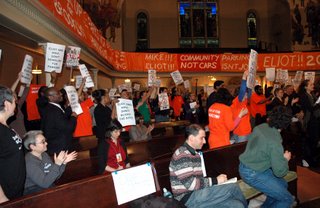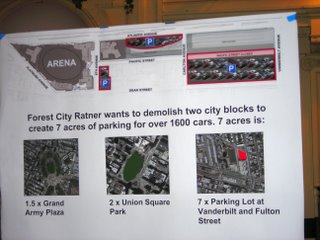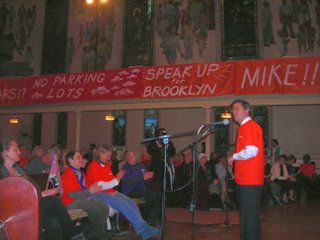 Despite stormy weather, more than 200 people—a respectable number given the wind and rain—came to the Lafayette Avenue Presbyterian Church (LAPC) in Fort Greene for a “Rally Against Demolition for Parking,” organized by the BrooklynSpeaks coalition, which seeks significant changes to make Atlantic Yards “a plan that works for Brooklyn.”
Despite stormy weather, more than 200 people—a respectable number given the wind and rain—came to the Lafayette Avenue Presbyterian Church (LAPC) in Fort Greene for a “Rally Against Demolition for Parking,” organized by the BrooklynSpeaks coalition, which seeks significant changes to make Atlantic Yards “a plan that works for Brooklyn.”The goal: to get elected officials, especially Gov. Eliot Spitzer, to take notice and intervene before Forest City Ratner’s (FCR) project proceeds further. Orange banners festooned the sanctuary, among them “Speak Up for Brooklyn,” “Don’t Blight the Site,” “Community Not Cars,” and “Parks Not Parking Lots.”
While presumably everyone attending supported the rally’s stated purpose, some go further, backing the lawsuits organized by Develop Don’t Destroy Brooklyn (DDDB), which thinks the plan should be scrapped, not fixed, and charges that eminent domain has been abused as part of a sweetheart deal. Perhaps half the attendees wore either the orange BrooklynSpeaks t-shirts given out at the door or the purple shirts of marshals. A few dozen people wore DDDB shirts. The rest avoided logos.
Of the several elected officials who spoke, Council Member Letitia James, whose opposition exceeds that stated by BrooklynSpeaks, drew the loudest applause.
 Near the front of the sanctuary, large posters explained the plan for interim surface parking and showed a potential outcome: the empty lots that persisted in the Atlantic Terminal Urban Renewal Area for decades. (Atlantic Yards is supposed to take ten years, but even project landscape architect Laurie Olin speculates that it could take 20 years.)
Near the front of the sanctuary, large posters explained the plan for interim surface parking and showed a potential outcome: the empty lots that persisted in the Atlantic Terminal Urban Renewal Area for decades. (Atlantic Yards is supposed to take ten years, but even project landscape architect Laurie Olin speculates that it could take 20 years.)Against blight
Hosting the meeting, Gib Veconi of the Prospect Heights Neighborhood Development Council, declared, “Instead of seven acres of open space, we’re getting seven acres of parking.”
“Is Brooklyn blighted?” Veconi asked the crowd.
“No,” the crowd roared back.
“Do we want Brooklyn to be blighted?” he continued.
“No!”
The criticism sounded not unlike the DDDB response to the Empire State Development Corporation’s (ESDC) questionable finding of blight, but BrooklynSpeaks and DDDB have different tactics.
“Stop the demolitions long enough to engage our communities,” Veconi said. A form letter, aimed at Spitzer, was distributed; it requested that Spitzer acknowledge the BrooklynSpeaks agenda, which include a revision of the open space and an avoidance of superblocks; a workable transportation plan; affordable housing made available to a broader range of incomes; and meaningful public involvement, such as a local development corporation. BrooklynSpeaks also asked for a "coordinator of infrastucture" to supervise the ongoing process.
 DDDB, for its part, distributed a statement reminding people that it believes no demolitions should proceed without community input, financial transparency regarding the project, and a resolution of the cases challenging the environmental review and eminent domain that DDDB has spearheaded--and continues to raise funds for--in state and federal court.
DDDB, for its part, distributed a statement reminding people that it believes no demolitions should proceed without community input, financial transparency regarding the project, and a resolution of the cases challenging the environmental review and eminent domain that DDDB has spearheaded--and continues to raise funds for--in state and federal court.DDDB announced a protest to be held at the corner of Flatbush Avenue and Pacific Street on Wednesday at 8 a.m., the morning FCR plans to start demolishing four buildings at that corner. The protest was announced in a handout and, in a gesture of inclusion, from the podium yesterday by Michelle de la Uz of BrooklynSpeaks, the final speaker.
While the lawsuit challenging the ESDC’s environmental review requested a temporary injunction to block demolitions, that motion won’t be heard until early May. On Tuesday, lawyers representing the plaintiffs will go to court to seek a temporary restraining order to block the demolitions scheduled for Wednesday. Among other things, they’ll have to convince State Supreme Court Judge Joan A. Madden that, as a not-for-profit organizations, the plaintiffs shouldn’t be forced to post a significant bond.
“Prove it in Brooklyn”
How did this happen? Veconi noted that Forest City Ratner spent more than $2 million last year lobbying the city and state to move the project along. (Note: the New York Times still has not reported this figure, which makes FCR the third-leading lobbyist and the leading developer by far.)
If Spitzer aims to be the reformer he claims, “prove it in Brooklyn,” Veconi asserted. (Spitzer expressed support for the project and refused to call for a delay last year, but has been generally uninformed about the project.) And if Mayor Mike Bloomberg wants to be known for his sustainability efforts, “prove it in Brooklyn.”
 Council Member David Yassky (right), the only elected official to actually don a BrooklynSpeaks t-shirt, blamed “a governor and mayor who did not listen to the voices who said this project does not work.”
Council Member David Yassky (right), the only elected official to actually don a BrooklynSpeaks t-shirt, blamed “a governor and mayor who did not listen to the voices who said this project does not work.”James on Day 1
James, who cited her upbringing in Brownstone Brooklyn (“I do not want to live in a vertical city”) was initially on message, citing “our commitment to change this project and make it right for Brooklyn.”
She called the parking plan “irresponsible and unwise and unsound planning,” but she also went further. Regardless of where people stand on the lawsuits she supports, she said, the parking lots will affect congestion and air quality and “erode our quality of life.”
 She attacked the premise of Atlantic Yards. The project “represents—hopefully will not represent—corporate interests trampling on Brooklyn,” she said. “More and more elected officials will recognize we were right from Day 1.”
She attacked the premise of Atlantic Yards. The project “represents—hopefully will not represent—corporate interests trampling on Brooklyn,” she said. “More and more elected officials will recognize we were right from Day 1.”After the rally, James (right) said that there was one sign of progress: Deputy Mayor for Economic Development Dan Doctoroff has asked for a meeting with elected officials who represent the area around the project site.
The parking argument
The ESDC has defended the creation of large areas for parking and staging as necessary to build the project, but the speakers yesterday weren’t buying that.
Jon Orcutt, executive director of the Tri-State Transportation Campaign, pointed out that “the infrastructure tells you what to do,” so the provision of parking sends a message. “You’re creating the capacity to drive.”
He scoffed at the explanation that the parking lot was needed for workers. “There’s nowhere in town where you see a gigantic parking lot” outside a construction site,” he said. “That’s arena parking, pure and simple.”
(Bruce Bender of FCR told Metro that using mass transit "is a tad difficult when your job requires that you arrive with tools and other gear." Metro was the only daily to cover the rally. Would better weather have drawn TV cameras to the rally, originally scheduled at an outdoor site on Pacific Street?)
“It’s just an obscenity to knock down building to build surface parking at Brooklyn’s transit hub,” Orcutt said.
Then again, if those building are preserved, notably the Ward Bakery on Pacific Street between Carlton and Vanderbilt avenues, that would require a major reconfiguration of Forest City Ratner’s plan. (There was a large poster of the Ward Bakery at the front of the sanctuary, but the value of the building itself was hardly mentioned by speakers.)
Adjustments necessary
 Assemblyman Hakeem Jeffries addressed the explanation that the surface parking lots aimed to avoid disruption. “If you were trying to resolve the issue of disruption,” he said, “let’s have a conversation about density,” implying that the project should be much smaller. “Let’s have a conversation about construction impacts. Don’t suggest that this parking lot is going to help.”
Assemblyman Hakeem Jeffries addressed the explanation that the surface parking lots aimed to avoid disruption. “If you were trying to resolve the issue of disruption,” he said, “let’s have a conversation about density,” implying that the project should be much smaller. “Let’s have a conversation about construction impacts. Don’t suggest that this parking lot is going to help.”If the developer will provide 1400 spaces for construction workers, Jeffries said, they would be coming in from outer suburbs: “I thought this project was about getting jobs for folks in the community.”
He suggested that if Spitzer can "stop the clock"--literally--to get the state budget passed, the governor could get involved in the project. (ESDC spokesman said in a statement that "ESDC plans to play a greater role in forging consensus between the community, various government agencies and developer Forest City Ratner.” What that means in practice, of course, remains to be seen.)
De Blasio hissed
State Senator Velmanette Montgomery, an Atlantic Yards opponent who was on the bill, did not attend, but Council Member Bill de Blasio, an Atlantic Yards supporter who was not on the bill, did appear.
De Blasio expressed concern about “the pace of change” regarding all development in Brooklyn. “I don’t honestly know what the rush is,” he said. “We need to reconceptualize how we plan communities.”
He allowed that such discussion would not necessary mean consensus and said of Atlantic Yards, “I believe some of this vision can work out.” Several people in the crowd hissed. “Hiss all you want,” replied de Blasio.
(Actually, the premise of BrooklynSpeaks is also that some of the project can work out, which is why BrooklynSpeaks opposes the demapping of streets for superblocks, but somewhat contradictorily accepts the arena superblock that would be Atlantic Yards Phase 1. The state must override city zoning prohibiting arenas within 200 feet of residences; DDDB points to the "inappropriate siting of an arena in a residential neighborhood.")
De Blasio said a plan was needed to deal with traffic congestion. “Until we have all that, it’s crazy to move ahead with any demolition.”
Adams & Miller
State Senator Eric Adams offered a twist on some of the rhetoric regarding those protesting Atlantic Yards: they’re not newcomers so much as old-timers who invested in their communities when Brooklyn needed it. He asked why “those who stayed during the difficult times should not enjoy the sunny days of prosperity?”
 The Rev. Clinton Miller of Brown Memorial Baptist Church, referring to the distinctive mural, “Mighty Cloud of Witnesses,” wrapping around LAPC's upper balcony, declared, “Somehow I get the feeling that this diversity I see around you will not reflect Atlantic Yards.” (The mixed but mostly-white crowd in the pews didn’t mirror the mural, either.)
The Rev. Clinton Miller of Brown Memorial Baptist Church, referring to the distinctive mural, “Mighty Cloud of Witnesses,” wrapping around LAPC's upper balcony, declared, “Somehow I get the feeling that this diversity I see around you will not reflect Atlantic Yards.” (The mixed but mostly-white crowd in the pews didn’t mirror the mural, either.)Making reference to the tax deadline, Miller called Atlantic Yards “another case of taxation without representation,” noting that local representatives were bypassed in the decisionmaking. And, again sounding a little like DDDB’s blight response, he declared, “Until recently, all the blight has been at the hand of the MTA.”
Site issues
While some speakers, including Jeffries, referred to "responsible development" on the "Atlantic Yards site," there’s nothing sacrosanct about the 22-acre outline; indeed, the charge that Ratner drew the map is part of the eminent domain lawsuit organized by DDDB.
Attendees were given flyers for UNITY 2007, a workshop on April 28 “to create a community driven development plan for Brooklyn’s Vanderbilt Yards”—in other words, just the 8.5-acre MTA property, not the proposed footprint.
The effort follows up on a 2004 effort organized by James to develop an alternative to Atlantic Yards. What emerged was the UNITY Plan and a set of planning principles. The new effort aims to provide “an updated and comprehensive plan” if Atlantic Yards is not built or partly built.
Lingering messages
 Welcoming attendees at the beginning of the rally, the Rev. David Dyson of LAPC advised, “Never, never, never give up. It’s not in the Bible, but it should be.” Later, the Lafayette Inspirational Ensemble offered an apt song: “Expect A Miracle.”
Welcoming attendees at the beginning of the rally, the Rev. David Dyson of LAPC advised, “Never, never, never give up. It’s not in the Bible, but it should be.” Later, the Lafayette Inspirational Ensemble offered an apt song: “Expect A Miracle.”However, another musical message might have been even more apt. A “transit-oriented marching band” (right), including those playing saxophone, trombone, recorder, and kazoo, offered an interlude of cacophonous honking. It was entertaining, but also a warning.
Comments
Post a Comment